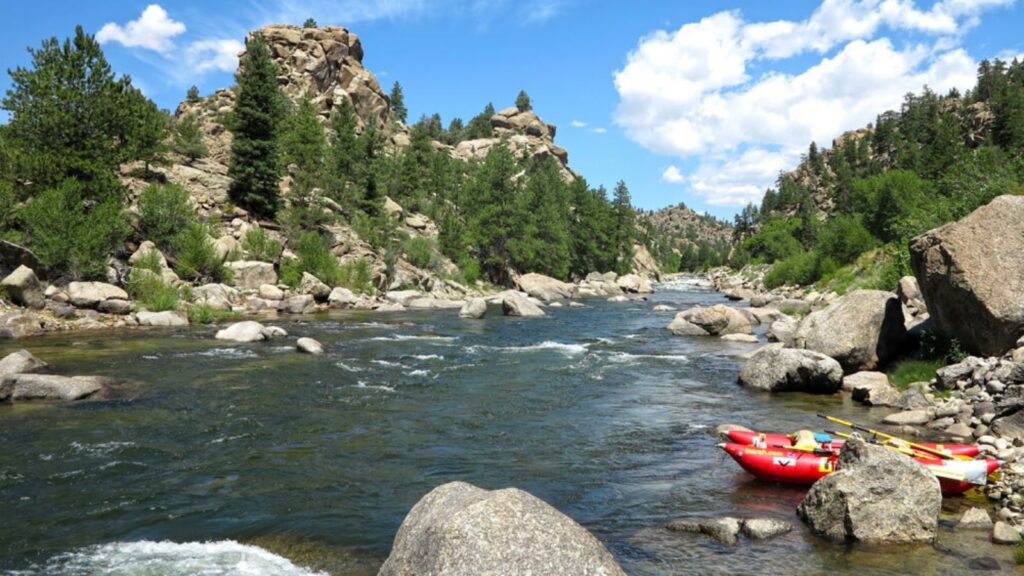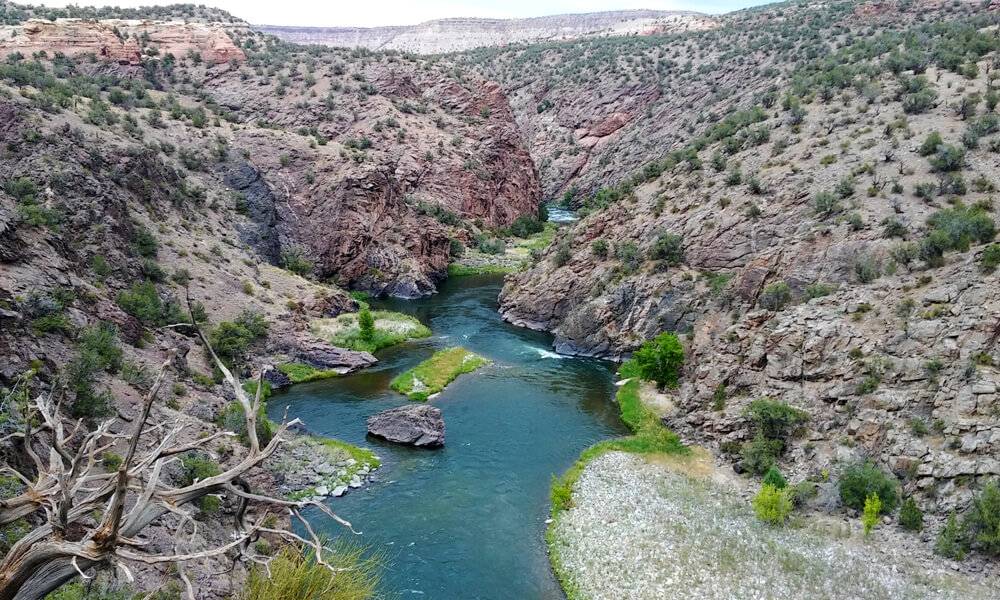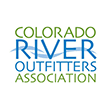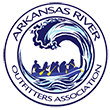River Rafting Levels in Colorado – INFOGRAPHIC

Carefully planning a whitewater rafting adventure is paramount to not only being safe, but also having a good time. Knowing what to expect on your rafting trip is key to making lasting memories while on the river. Similar to downhill skiing and rock climbing, river rafting uses a scale of difficulty to convey the skill level required to navigate sections of rivers. While a skier is aware that a black diamond run is steeper and is more difficult to ski down than a green or blue run, river guides and rafting enthusiasts are aware that rapids, like ski runs, vary in intensity. The scale to determine the intensity of rivers was developed by by the North Carolina-based nonprofit American Whitewater and is recognized globally by rafters, kayakers and conoeists alike. The classification system, or International Scale of Difficulty, ranges from Class 1 for beginners to Class 6 for the elite. River Classification System Class I: Easy. Mostly flat, slow moving water with the occasional small wave. Clear passages and no severe obstacles. Class II: Mild. Small rapids, low in difficulty with clear passages and a few minor obstacles. Class III: Moderate. Numerous, medium sized waves. Clear, narrow passages requiring maneuvering. Rapids with rocks, creating some severe obstacles. Class IV: Difficult. Rapids are long, with powerful waves and rocks creating potentially dangerous hazards. Precise maneuvering through narrow and/or rock-choked passages. Class V: Extreme. Difficult, long and violent rapids, close together in distance. Big, powerful drops, along a steep gradient through forceful currents. Pinpoint precision maneuvering through tight passages and around frequent severe obstacles. Class VI: Considered unrunnable! Do not attempt. Waterfalls and other unavoidable life-threatening hazards. While the scale isn’t exact, subjective factors such as skill level, season and river conditions at the time the river is paddled can influence the classification system. Before heading out on the river, knowing your comfort and skill level before embarking on your white water adventure will help ensure you and everyone else in your raft has a good time. Arkansas River Rapids Classes We are lucky in Colorado to have a handful of great rivers to raft on. Even better is the fact that the Arkansas River is rated as one of the Top 10 rivers in the US for white water rafting. Take a look at the infographic below for our favorite sections. At Wilderness Aware Rafting, we understand how a proper family rafting vacation can create some of the best memories a person can have. If you are interested in an Arkansas River rafting trip or want to try rafting the Salt River near Phoenix, AZ, please be sure to contact us and find out what white water rafting trips we have available.
10 Reasons Why We Need to Protect Our Rivers

A great snow season means more snow melt and water for our rivers. With warm weather hitting spring earlier, reservoirs are releasing water from their dams and filling the rivers sooner. And that is good news for us—the rafting season starts earlier! For all of you itching to get on the river, you don’t have to wait until summer begins. Besides depending on a great snow season for full rivers, it’s important that we be active in protecting our rivers too. Not only are healthy rivers necessary to hit some hardcore rapids, they’re necessary for the ecosystem around us. The plants and animals surrounding the river and canyon would not thrive and be as beautiful as they are if our rivers were polluted. Water is important for everybody and everything’s health. The human body is 55-60% water. The Clean Water Act The Clean Water Act of 1972 has helped to keep “billions of pounds of pollution” out of our rivers by addressing point sources like wastewater treatment plants and factories (AmericanRivers.org). However, a lot of polluted runoff is picked up along city streets and farmlands. This act came about after people began to realize how dirty rivers were. The Cuyahoga River caught on fire due to oil slicked pieces of debris and if you fell into the Potomac River, you needed a tetanus shot. The Colorado River itself supplies 36 million people with water from Denver to Los Angeles. About 78% is used for agriculture, which grows 15% of our nation’s crops. Ultimately, rivers are a vital part of living. They tell a story, provide geologic, ecological, biological, and human history, shape culture and societies, provide transport, purity, and more. A deep respect for the river is cultural and together we can work to embed that respect in others to maintain and improve the health of our rivers. For those of you who worry that your small actions won’t make a difference, consider everybody that you share this information with, those who already make an effort, and how all these actions will collectively and positively improve the health of our rivers. Reasons to Protect our Rivers Make rivers safe for people to use Protect river ecosystem Help plants flourish Allow animals to thrive Keep pollution out Clean drinking water Agriculture Protect geologic, ecological, biological and human history Helps shape cultures and societies Transportation Check out this list of 50 Ways to Save Your River for more ideas on how you can help. See you on the river!
What is Black Water Rafting?
Black water rafting isn’t white water rafting through Mordor but it actually is going tubing through caves. There are active rivers running through caverns and in the 1980s, New Zealand cave explorers decided to clamber into the Waitomo Glowworm Caves with inner tubes and revel in the awe of twinkling phosphorescent glowworms on the cave ceilings as they cruised underground. Black water rafting is cave spelunking meets white water rafting. It’s referred to as black water because, well, you’re in a dark cave and your inner tube is the small raft. Many times, the natural urge to connect tubes together is how it becomes, “rafting.” At times, rafters peacefully float through as if looking up at a starry night sky but getting there requires some hiking and more heart-pumping thrills. Extreme-sports enthusiasts enjoy the adventure of cave spelunking, rappelling to the rivers, and enjoying the rush of floating through rapids and drops. Where is Black Water Rafting Available? Black water rafting tours are only commercially available in New Zealand and Belize. Many of the available tours are at least 3 hours long and a great way to get in your nature therapy. Since journeying through caves can generally be dangerous, it’s always best to go with a guide who knows the cave and river inside out. Often, some parts of the route will require zip-lining down. The caves where black water rafting are available are usually only accessible through a guide. New Zealand only offers rafting in the Waitomo district and in Belize, the Yucatan caves offer a spiritual look inside the Mayan culture. With the rarity of these cave tubing trips, it’s definitely a unique experience that should not be passed up. Can I Take Myself Black Water Rafting? Taking yourself black water rafting without a guide is not recommended. Getting lost inside a cave is a great way to be lost for a very long time as there are many routes and rooms that lead away from the main path. Guides will provide you with all the essential equipment that you need and be able to help you in case of an emergency. Some of it includes wetsuits, inner tubes, helmets with headlights, water shoes, rope, first aid, and snacks. Some other things to consider are whether you’re claustrophobic or acrophobic. Some parts of caves are very open with high ceilings but it can easily get narrow and you may be floating on your tube with the ceiling right above your head. Other areas have steep drops where some people jump into or zip-line down. Going black water rafting just might make some of you feel like Lara Croft from Tomb Raider. If you’re ready for a rafting adventure but not quite sure about doing it in caves or have a fear of heights, good old white water rafting in the open air should suit your itch for adrenaline outdoors. Check out the White Water Rafting Trips & Raft Trip Packages we have available and get your adventure on.
The Best Waterproof Cameras for Whitewater Rafting
We love taking action shots on the river whether it’s with a digital camera or the CableCam and guests often wonder, what’s the best waterproof camera to take along for rafting trips? Deciding on the best all-around waterproof cameras requires considering the integrity, construction, durability, and actual waterproof ability of the camera. We also focus on those can also take fantastic movement shots as rafting is a sport continually in motion. Other activities in motion that you are likely to take your waterproof camera on are trips like hiking, kayaking, off-roading, to the beach, and more. Having a camera that you can rely on through each adventure is all that we ask for. Optical zoom, pixels, design, shock absorbance, size, anti-motion blur, and price are important to consider when choosing the right camera. Here is our list of the best waterproof cameras for whitewater rafting. Panasonic Lumix TS5 Why It’s Awesome: Built with WiFi technology, there are many features on this camera that allows you to utilize your smartphone or tablet to make things easier. For example, once you snap an image, you can quickly view and share it on your smartphone or tablet using Near Field Communication or edit with effects on the camera. Record videos using the camera or control it from a distance too. Take pictures in and out of water or under water. Another bonus is a built-in GPS allowing you to identify your location. Average Price: $279.99 Dimensions: 4.3 x 2.65 x 1.14 inches Weight: 214 grams Megapixels: 16.1 megapixels Optical Zoom: 4.6x LCD Size: 3 inches Waterproof: 13 m/43 ft Shockproof: 2 m/6.6 ft Dustproof: Keeps out sand or dust particles Freezeproof: -10°C/14°F Pressure Resistance: 100 kgf Anti-Motion Blur: Available Nikon COOLPIX AW110 Why It’s Awesome: A camera meant for exploring, the COOLPIX has a built-in GPS and Electronic compass, which also shows nearby Points of Interest. Using the Nikon View NX2 software, you can share your adventures online. Sensitive images CMOS sensors allow you to take low-light photos without a flash but not necessarily the best at this trick. Average Price: $249.95 Dimensions: 4.4 x 2.6 x 1.0 inches Weight: 6.9 oz/193 g Megapixels: 16.1 megapixels Optical Zoom: 5x LCD Size: 3 inches Waterproof: 18 m/59 ft for 60 minutes Shockproof: 2 m/6.6 ft Humidity Resistance: Less than 85% Freezeproof: -10°C/14°F on land & 0°C/32°F underwater Crushproof: 100 kgf/220 lbf Anti-Motion Blur: Available with Lens-shift Vibration Reduction & Automatic Motion Detection Olympus TG-2 iHS Why It’s Awesome: This camera is built around underwater shooting, including an ultra-bright, high-speed f2.0 lens for low light action. The water-repellent lens coating lets you focus on shooting rather than wiping off droplets. Also and adventuring camera, it includes a GPS and e.Compass with the ability to mark your location on a map using a manometer that detects and records elevation, water depth, and warns you when you get too deep. Give your images a quick edit using 11 filters and beauty makeup mode. Average Price: $379.99 Dimensions: 4.4 x 2.6 x 1.0 inches Weight: 6.9 oz/193 g Megapixels: 12 megapixels Optical Zoom: 4x LCD Size: 3 inches Waterproof: 15 m/50 ft Shockproof: 2.1 m/7ft Dustproof: Yes Freezeproof: -10°C/14°F Crushproof: 100 kgf/220 lbf Anti-Motion Blur: Available with Lens-shift Vibration Reduction & automatic Motion Detection Pentax WG-3 GPS Why It’s Awesome: This rugged-looking design appeals to adventurers with a fast lens. It includes 6 LEDs for macro mode shooting that can get as close as 1 centimeter from the lens. The close zoom is effective with underwater shooting as targets need to be as close as possible for clarity. However, it does struggle with low-light shots. A plus for charging is its ability to utilize inductive charging (aka “wireless charging”). Like the other cameras, it has a built-in GPS for geotagging and a digital compass with pressure sensor, altitude, and direction sensors. Average Price: $299.95 Dimensions: 2.5 x 4.9 x 1.3 inches Weight: 8.4 oz/239 g Megapixels: 16.0 megapixels Optical Zoom: 4x LCD Size: 3 inches Waterproof: 13.7 m/45 ft Shockproof: 2 m/6.6 ft Freezeproof: -10°C/14°F Crushproof: 100 kgf/220 lbf Anti-Motion Blur: Available with Lens-shift Vibration Reduction & automatic Motion Detection Nikon 1 AW1 Why It’s Awesome: The most expensive of these cameras, it comes with a 11-27mm kit lens, the world’s first interchangeable underwater lens. All Nikon lenses are also compatible with this sleek camera. It’s WiFi compatible with a built-in GPS and lets you share images on your smartphone. Average Price: $749.95 Dimensions: 4.5 x 2.9 x 1.5 inches Weight: 11.1 oz/313 g Megapixels: 14.2 megapixels Optical Zoom: 5x LCD Size: 3 inches Waterproof: 14.9 m/49 ft Shockproof: 2 m/6.6 ft Dustproof: Yes Freezeproof: -10°C/14°F Crushproof: No Anti-Motion Blur: Available Once you’re ready to take your future new waterproof digital camera on its first adventure, be sure to check out our whitewater rafting trips for your camera’s first rafting trip.
Rafting as Team Building Exercises
Whitewater rafting is an excellent way to encourage camaraderie and strengthen workplace relationships. Team building exercises don’t have to be at a nearby park or in a meeting room of the workplace to be effective. Most employees enjoy team building a lot more when it takes place in a new environment and involves participating in sports and fitness activities together. You don’t have to sit around telling your deepest fears and walking on hot coal in order to build up your team spirit (unless you really want to). Let’s take a look at the top reasons people organize team building activities and how you can carry out those exercises using rafting. Some of these you may prefer to choose a calmer river to use. Improving Communication Each person in the raft will spend 5-10 minutes as the “guide” and direct the group which way to paddle in order to avoid obstacles or make turns along river bends. Work together to reach different markers and rotate among every employee in the boat without falling behind the other rafters. Employees learn to react to the environment and flow of the river while having the ability to foresee upcoming obstacles and quickly respond. Learn Personal Backgrounds Starting with the person in front right side going clockwise, the first person will tell a story from when they were a small child. The next tells a story from their childhood, then preteen, then teenager, then young adult, etc. In this manner, each person gets to share a part of their background from a different stage while remaining part of the team paddling together. The other members practice listening skills and have the ability to engage with the story-teller on a more personal level too. Trust Everyone in each raft except one person is blind folded and the one with sight has to guide everyone to paddle across a river. Teams will race back and forth across the river and rotate guides until each person has guided the raft to shore. This exercise encourages employees to trust the guidance of each other while the person guiding must adjust their instructions and communication to get their team to paddle effectively as they depend on their advice. Collaboration Set up a worse-case scenario such as: the bus forgot to pick up the rafters and they have to stop on a shore and spend the night next to the river. Ask the team to work together to decide what indicators of the river shore would make them choose to stop there, how they would set up a fire, get fresh water, find food to eat, and set up a shelter based on things they see along the river. Have them come up with a list of 10 things they must do in order to survive the night. Using rafting for team building helps to provide a fun and engaging environment for employees to work on their interpersonal and communication skills together while also valuing their individual skill sets. It helps teams to learn in practice instead of in theory alone while experiencing immediate consequences and requiring creativity and critical thinking to respond with. Plan your team building river rafting trip with us at Wilderness Aware Rafting today. Our Browns Canyon Half Day Trip is our most popular on the Arkansas River. Contact us online or call us for more information 1-800-462-7238.
White Water Rafting for Beginners
The song of the river ends not at her banks, but in the hearts of those who have loved her. -Buffalo Joe White water rafting is an exciting outdoor adventure for everyone, including children and senior adults. If this is your first or second time rafting, there are probably some questions and concerns crossing your mind. The first part of having a great time white water rafting is finding out what beginners need to know and what to look for in a rafting company. Safety Precautions White water rafting is a thrilling sport for all ages. Like many adventure sports, there is risk involved in participating. Traveling with a company that takes the time to teach you safety measures such as how to properly wear a life jacket, helmet, and personal gear is crucial to having a good time. Well-trained guides will coach everybody on their raft how to get in and out of boats, paddle, where to place their feet, rafting language, and what to do in the event of an emergency such as an upturned raft or if someone falls out. In this manner, everybody is educated and more confident, and the guide can better minimize any dangers. If you have any worries about your ability to raft due to your physical health, check with your doctor beforehand. Swimming Abilities Many people are worried about falling out of the raft and not being able to swim. Guests must be at least 7 years old to participate for safety reasons and all of our guests are required to wear a lifejacket and helmet, which eliminates the worry of staying afloat so everyone can have a great time. Guests can choose from a variety of skill levels that they are most comfortable with. Trips that are Class II-IV are suitable for beginners. Wilderness Aware Rafting professional guides work to educate everyone at the start of each trip on what to do if they fall out of the raft and how to properly float down river to the riverside where they will be picked up with little, if any, injuries. If there is a part of the river with any risk of falling out, we’ll be sure to warn you to “dig in” before we hit the rapids. For many people who do fall out, it’s actually the most exciting part of the trip that they enjoy telling others about. Well-Trained & Knowledgeable Staff Wilderness Aware Rafting earned the 2012 Better Business Bureau’s “Excellence in Customer Service” award and we have been twice named Colorado’s Company of the Year. Every member of our staff works to maintain our excellent safety record since 1976. The owner and management team is involved in daily operations and making sure guests have an excellent experience. Part of the awesome experience of taking a trip with us is the trust and care that our guides are professionally-trained, First Aid and CPR certified, and drug-tested. We also make sure that our guides are fun and easy to get along with. Preparing for Your First White Water Rafting Trip The day before your beginner white water rafting trip, make sure you pack the right gear to have a comfortable and fun time. We don’t recommend wearing cotton at all because you’ll stay soaked and cold longer. Bring a swimming suit and wetsuit. If you don’t have a wetsuit, they are available to rent. We do recommend sunglasses with a securing strap and hat since the glare reflecting off the water and canyons can be harsh on the eyes. Water resistant sunscreen is a must to avoid burns. For your feet, bring tennis shoes that you are ok with getting wet or secure sandals. Lastly, also bring a change of clothes, towel, water bottle, fleece jacket, and cash. Are you ready to sign up for a beginners’ trip? Browse our selection of white water rafting trips or contact us today to get started.
The Lessons of Rafting: How Rafting Can Be Used as a Business Team Building Exercise
To me, teamwork is the beauty of our sport, where you have five acting as one. You become selfless. -Mike Krzyzewski Good businesses know that team work is important, whereas great businesses know the importance of team building. If you’re looking for a fun and creative way to improve your workplace atmosphere, energy, and synergy, taking your employees for a day of whitewater rafting is it. A 2012 Wakefield Research Study shows that almost 31% of employees dislike team-building activities so skip the typical trust exercises. Let’s take a look at all the reasons why whitewater rafting is great for team building. 1. We Offer Food One of the best ways to improve workplace relationships is to have them share a meal together. If you think about it, anytime there’s a celebration, it involves gathering together for a meal. At Wilderness Aware, we offer deli-style lunches on our full-day trips and free continental breakfasts. There’s even a shaded meeting area and riverside picnic site for groups to gather and reminisce about their day on the river. 2. Team Work at its Best Another effective team-building activity is to have employees participate in fitness or sports activities together. When each person has a critical role in the raft to paddle through eddies and challenging obstacles, it sets up an open environment for bonding and encouragement. Looking back at our roots not 50 years ago when office jobs were uncommon and people physically interacted on a daily basis, you see a huge improvements in relationships. A change of scenery with a common goal gives people a fresh outlook. 3. Nature Therapy is Awesome Being outdoors and working together in Mother Nature spurs nature therapy and an experience that they’ll never forget. Nature therapy can have regenerative powers that diminishes stress, anxiety, and depression. It is a great way for people to relax together and unwind. Being outdoors also improves physical health and mental clarity. People talk and bond more when they are moving, and in this case, paddling their oars through whitewater! 4. Fun is an Option Setting up a getaway that allows employees to enjoy themselves and have fun taps into the most basic way that humans and animals improve their social skills: learning through play. It also lowers blood pressure and increases friendly pats on the back. When co-workers feel more comfortable interacting with one another, workflow and quality improves because people aren’t hesitant about approaching one another for advice or suggestions. When employees can connect to one another, it improves their happiness with their workplace. The workplace culture is taking two directions: companies that care about employee retention and a quality workplace, and companies that have high-turnover, which is usually their best employees leaving for something better. A team-building activity that is actually fun and exciting will spur innovation while also showing your employees that you do care about their overall well-beings and happiness at work. Whitewater rafting is an exciting outdoor activity that encourages team-building in an exciting and unique way. If you’re interested in planning a day on the river for your company, contact us at Wilderness Aware Rafting and we’ll be happy to help you get started.
10 Life Lessons Learned From Whitewater Rafting
If you’ve done a certain activity for long enough, eventually lessons will start presenting themselves to you. The lessons may not always be clear, and they may not even be noticeable at first. But through trial and error, enduring hardships, and endless questioning, the world becomes a little clearer. The life lessons that follow here are based on my experiences of whitewater rafting and being out in nature for extended periods of time. This is not to say some of these lessons wouldn’t have been learned otherwise, it’s just rafting happened to be the teacher in these instances. You Never Know What Lies Ahead Without Scouting Before making any serious commitment or decision, especially one that would be difficult to undue or break, be sure you know exactly what it is you’re getting yourself into. You never know what lies around the bend in the river, or life, unless you first investigate and explore it. The Sun Illuminates and Brings Facts to Light Better Than a Bulb If you ever have a question that needs answering, a concern that needs easing, or a problem that needs solving, many times you’ll find your solutions more easily while contemplating outdoors. Something about the fresh air, wide open spaces, and the suns warm glow allows our minds to wander more freely. It helps to let our emotions calm down and clear any clouds in our judgment. Physical Exhaustion is Often Better than Mental Physical exhaustion is easier for your body to deal with and recover from than being mentally tired. Physically, your muscles may be sore and ache, but after a good meal and full nights rest, your body can recover rather quickly. Being physically tired brings better sleep, the exercise helps to keep you healthy, and overall you may become happier. Your mind on the other hand does not find these benefits of being tired. After working your mind for too hard for too long, stress, anxiety, depression, confusion, and irritation can set in, all of which can be rather difficult to overcome. This is especially true over long periods of time. Your body can rest once you stop moving, your mind is not so easily turned off. Character Is Truly Exposed When Times Are Hard You never know the true character of a person unless their character is tried in some way. Sort of a trial by fire, you never know what someone is capable of until they are faced with difficult times to see how they react. In some cases you’ll be pleasantly surprised; in others you may be sadly let down. But none of this will be known until the person is tested in a trying fashion. To Live Life to the Fullest Means You Have to Fully Live Anyone who is alive can be said to be living. But living fully is entirely different, and of course depends on the person whether or not that is being achieved. People only have one shot through this life and there is no point in not living how you want to live. Living fully means following your heart, doing the things that you enjoy and bring you pleasure. Simply having a heartbeat does not mean you’re living… making your heart skip a beat however does. Many of Our Worldly Woes and Concerns Are Meer Figments of Our Imagination When it comes down to it, if you are truly able to consider it with an objective mind, most problems we face on a daily basis are not necessarily “real”. Many of our negative thoughts and feeling can be easily overcome through proper thought. Our thoughts create our reality, and our beliefs are the filter of our reality. If we think positively and believe fully that our thoughts are true, rarely will such negative thoughts hold any weight or meaning. Long Term Happiness Cannot be Found or Gifted, It’s Personally Created People mistakenly believe happiness is something you can purchase, be given, or even just wake up with. It’s somehow believed that happiness is continual and can transfer over from the day before. But that’s not the case, happiness arises from your daily activities and has to be personally generated and created every day. You become happy by doing things you enjoy, you stay happy be continuing to do those things. Without Hard Work There Is Little to Gain to Be Proud Of Little in the world that has value can be had or achieved for free. Typically, the more something is worth, the more that thing will cost. Hard work certainly isn’t fun, but that’s why it’s called work. Most goals people set for themeselves are valuable and rarely are they easily achieved. This is what makes achieving those goals so meaningful, it’s the fact that it wasn’t easy. Which did you find more pride in when you were in school, getting a B+ on that difficult exam you studied endlessly for, or getting a gold star for your participation in class? Chances are it would be the B+ score, because you worked hard to achieve that which gave it greater value. Failure in Life Teaches More than Success There is more to learn from failure than success. In fact you don’t learn much from doing something perfectly correct because you did it right the first time. The least you’ll learn is to do the same process again as it already worked. Valuable lessons are learned and built upon failure because you realize where you went wrong and figure out how to adjust to make it better. Trial and error is the classroom of life while failure is its teacher. Fear is The Root of All Evils Fear is stifling, cancerous, and can create most of the evils that plague people. Vanity can arise from a fear of physical appearance. Greed can arise from a fear of poverty. Arrogance can arise from a fear of not being important. Gluttony can arise from a fear of there not being enough in the
Essential and Comfort Items You’ll Want on Your Next Multi-Day Rafting Trip
Have you ever noticed that when someone complains about camping or any multi-day trip outdoors in general, they are usually complaining over being ill prepared? Whether they couldn’t sleep, eat, were too hot or too cold, most problems and discomforts are avoidable through proper planning. The only thing that makes being outdoors miserable is not being properly prepared. Having to bear the elements without sufficient gear, or comfort items, makes the difference between an awful trip and a great one. Before your next multi-day whitewater rafting trip make sure you have everything that you need and also make you much more comfortable. One of the greatest benefits of camping while rafting is that you don’t have to physically carry all your gear on your person. The raft bears the weight, you simply have to steer and paddle it along. This allows us to bring many more comfort items, which would otherwise be left behind due to size or weight. That said, let’s go over some items you should consider bringing for your next multi-day rafting trip and ones you should definitely bring. Critical and Essential Items The exact gear you will need depends on whether your rafting trip is guided or not. Typically, rafting companies provide water, food, cooking equipment, rafting and safety equipment, first aid, portable toilets, and waterproof storage bags. Be sure to check with the rafting company itself to make sure that nothing important is forgotten or that you need to provide yourself. If you are not using a rafting guide company, be sure to pack these critical items with your gear. Once the critical items are taken care of, we move on to the essential items needed. Nothing will keep you happier during a rafting trip than having the right outerwear with you for any given situations. These include: Hats: You’ll want a visor or cap to shield you from the sun during the day. You will be thankful for the extra amount of shade when the sun is beating down on you. Also, bring a warm beanie to wear at night. After a full day of being wet, when night falls and the cold sets in, any extra heat you can keep will make all the difference to your happiness and comfort. Footwear: There are three sets of footwear you will need to consider bringing. Sandals and lightweight tennis shoes for wearing in the raft. Hiking shoes or boots in case you take an afternoon hike or need to traverse difficult terrain. Something warm and comfortable for camp such as camp slippers. Don’t rely on your rafting sneaker to hike in or wear all day. Your feet will not be able to take being wet for very long and it’s important to give them a break and dry out when you can. Clothing: Rafting presents various situations to pack clothing for: the potential of getting wet, traveling on land at higher elevations, hot summer days, and cool summer nights. Each of those conditions requires certain clothing items to remain comfortable. While rafting trunks work best, and if the water is cold you may want to bring a wetsuit in order to stay warm. If a wetsuit seems overboard, a splash jacket will help to keep you dry. Bring clothes to wear at camp or when hiking. When night falls, temperatures drop, especially at higher elevations, which means you should bring a warm jacket and/or a sweater and long pants. Considering it might rain, bring a rain jacket or poncho just in case. Finally, bring a pair of the almighty sunglasses. Spending a full day on the river is going to put a beating on your eyes as the sun reflects off the water and canyons. Similar to snow blindness, you can actually burn your eyes due to the waters reflection over a long period of time. Bring a good pair of UV protectant sunglasses with sunglass straps, you’d hate to look over the raft or hit a big wave only to have your glasses fall into the water. Safety Items: Don’t forget to bring sunscreen when you go rafting. Getting sunburnt your first day out is bad enough, continuing to get burnt every subsequent day after is awful. There is also the risk of having a heat stroke. Avoid this pain by ensuring you use sunscreen every day before setting out and periodically applying it throughout the day, especially after you get wet. You will also be thankful to bring bug spray as well. Insects can be a major pain when outdoors, especially when they are persistent and en masse. Developing a blister on your hands from paddling can be painful, having to continue paddling without protection to those areas can be excruciating. Bring a basic first aid kit to treat any scrapes, cuts or blisters during your trip. Camping Gear: At the end of a long day and after you’ve had your fill with dinner, you’ll want nothing more than to slip into a deep and full sleep. Be sure to pack a tent, sleeping bag, and sleeping mat. Your sleeping bag and mat are the most important factors that determine the quality of sleep you will be getting. The sleeping bag should preferably be synthetic in case it becomes wet. Your sleeping mat should also be carefully chosen. You can use simple foam mats, but nowadays they have inflatable sleeping mats which help tremendously by giving you a firm yet soft surface to sleep on. Foam mats help to soften the ground, but any bulges or rocks you sleep on will be felt. Beyond the first aid kit, you should also have a full medical bag. Your medical bag is only as good as you make it, so be sure you take everything into account when creating it. Consider the possible injuries that might occur and plan accordingly. Consider headaches, migraines, sprains, abrasions, cuts, tear, punctures, burns, splinters, specialty medication, and anything else you can fathom and pack accordingly. Finally, the last
Looking for the Perfect Gift? Try White Water Rafting!
In the words of Oscar Wilde, “Experience is one thing you can’t get for nothing.” When it comes to determining a gift for someone, sometimes a physical object or trinket isn’t the best option. How many gifts have you received in the past that you never used? How many gifts have you given that are actually enjoyed? How can a gift be truly valued by the receiver? Well experience is one thing you can’t get for nothing, it doesn’t just occur out of thin air. You have to go and actually do something, or have something done to you, in order to receive it. Sometimes people don’t make an earnest attempt to actually live. They refuse to go outside of their comfort zone to find new and wondrous things in this world. In short, they don’t experience life to its fullest. Before you buy your next gift for someone you should truly consider what that person might enjoy. Chances are you’ll soon realize that whatever toy, widget, or object you were thinking of giving isn’t actually that great of a gift after all. Of course this isn’t always the case, but a great number of gifts can be outgrown, broken, lost, or forgotten. Most people value good memories and positive life experiences much higher than personal possessions and novelty items. A thousand people can have the exact same item, but an experience is personal and one of a kind. Let’s take a surprise birthday party for example. What is remembered most? The surprise of family and friends, the celebration, spending time with loved ones, or the piles of wrapped gifts? If you were asked to tell of a time when you were certainly happy, it probably wouldn’t be when you received that pretty new sweater for Christmas, or even upon being gifted that new car for your 16th birthday. There is no doubt; some gifts are indeed awesome, such as a new car. However, there is no object in this world that can replace good company and life experiences. The purpose of life isn’t to accumulate objects is it? It’s to live. For that reason one of the best gifts you can give is the gift of experience, especially experiences shared with others. 3 Reasons Why Rafting Makes for A Great Experience Gift There are 3 good reasons that make Whitewater Rafting a great experience gift: The inherent adventure of rafting, the valued memories it creates with friends and loved ones, and the real world experience it gives in this digital age. Adventure Without a doubt, whitewater rafting is exciting, thrilling, and gets the adrenaline pumping. For someone who has never experienced it before, chances are it will be one of the most adventurous things they’ve ever done. This is especially true for multi-day trips where they truly get to experience the excitement of the outdoors beyond a few hours and, of course, depends on the actual river chosen. Some rivers or certain sections can be rather lazy in nature, which are great for younger or older folks. But if given the real paddle gripping, white-knuckle experience of a more difficult river, it’s an experience, and a gift, that won’t soon be forgotten. Shared Time and Memories Created One of the best parts about giving experience gifts is that the gift giver can experience them as well. Friends and family can join and this often makes the experience all the better if they do. Time on the river gives people a break from their hectic daily lives, and allows them to fully be in the moment while enjoying themselves in the process. Being able to share in that with them is meaningful. Having fun, trying something new or daring, going outside of what their normal daily expectations may be, is something to be cherished and remembered for a long time. Many times a whitewater rafting trip won’t be forgotten and I’m sure you can recall a few cherished memories yourself. Real World Experience… Not Virtual If the gift receiver rarely ventures outdoors into nature, they will literally sit in awe as they gaze at their surroundings. Some people tend to forget that the natural beauty of this world around rivers is well worth the journey to go view and explore it. Usually, you don’t get the whole picture viewing Earthporn online, such as the sights, sounds, taste, and feel of being present outdoors. Experiencing these scenes in real life is much more moving and meaningful to a person than viewing it through a computer screen. How many hours a day do you typically spend staring at a screen? Most of our daily lives are predominantly virtual, from shopping to banking, and socializing to working. Most of what we experience in a day occurs with a screen no more than a foot in front of our faces. An experience gift of whitewater rafting would change that and perhaps pump a little life back into the people going. Being outdoors and seeing the world with your own two eyes has oddly become something you have to coax people into doing. An experience gift is a great way to coax people into trying something new, different, and outdoors. There is more to giving a gift than wrapping a box and handing it over. Giving a gift is an opportunity to really show that you care for someone, and that they are worth giving a gift to in the first place. Don’t discount that idea and try to consider something that is sure to surprise. A guided whitewater rafting trip is only one such idea, and there are countless others. Horseback riding tours, zip lining adventures, scuba diving lessons, skydiving… there are many options. You just have to be clever, be thoughtful, and you’re gift will no doubt be sure to surprise and amaze. Who knows, perhaps we’ll even see you on the river soon. At Wilderness Aware Rafting, our utmost passion is being the best river rafting guides we can be. This ensures we offer the







